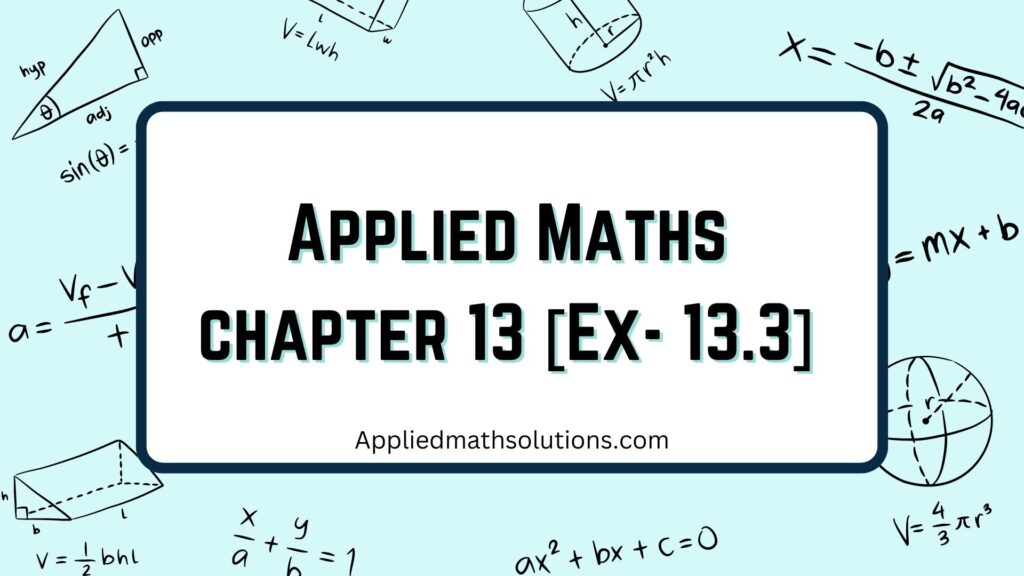Welcome to Class 12 Applied Maths Chapter 13, where we embark on an exciting journey into the world of advanced mathematical concepts tailored for Class 11 students.” Unlock the power of applied mathematics with expert solutions crafted by professionals at AppliedMath.com. Designed to propel students towards academic success, our meticulously curated ML Aggarwal Solutions for Applied Mathematics cater to Class 11 and class 12 students seeking mastery in their examinations. Every query from the CBSE ML Aggarwal Books finds a comprehensive answer on our platform, complete with detailed explanations and step-by-step solutions presented in an easily understandable language.
Dive into the world of applied mathematics and discover how our resources can elevate your understanding and performance. Keep reading to explore the wealth of ML Aggarwal Solutions for Class 11 and Class 12 Applied Mathematics.
Here we provide you with Class 12 Applied Maths Chapter 13, to help you gain a comprehensive understanding of the chapter and its concepts. https://appliedmathsolution.com/wp-admin/post.php?post=6&action=edit

Class 12 Applied Maths Chapter 13 Solutions
Return, Growth And Depreciation
EXERCISE- 13.3
Q.1 A piece of equipment that costs ₹25000 has an estimated useful life of 8 years and 0 scrap value. Find the annual depreciation using linear method.
Ans. Cost = Rs.25000, Scrap Value = 0, n = 8
Depreciation = (Cost – Scrap value)/n
= (25000 – 0)/8
= 25000/8
= Rs.3125
Q.2 A machine costing Rs.30000 is expected to have a useful life of 13 years and a final scrap value of ₹4000. Find the annual depreciation charge using straight line method.
Ans. Cost = Rs.30000, Scrap Value = 4000, n = 13
Depreciation = (Cost – Scrap value)/n
= (30000 – 4000)/13
= 26000/13
= Rs.2000
Q.3 An asset the life of which is estimated to be 8 years costs ₹80000. If annual depreciation is Rs.9000, find its scrap value using linear method.
Ans. Cost = Rs.80000, Scrap Value = ?, n = 8, Depreciation = Rs.9000
Depreciation = (Cost – Scrap value)/n
9000 = (80000 – S)/8
72000 = 80000 – S
S = Rs.8000
Q.4 A vehicle costing ₹900000 has a scrap value of ₹270000. If annual depreciation charge is Rs.70000, find its useful life in years.
Ans. Cost = Rs.900000, Scrap Value = 270000, n = ?, Depreciation = Rs.70000
Depreciation = (Cost – Scrap value)/n
70000 = (900000 – 270000)/n
70000 = 630000/n
n = 9 years
Q.5 A machine has a scrap value of Rs.22500 after 15 years of its purchase. If the annual depreciation charge is ₹8500, find its original cost using linear method.
Ans. Cost = ?, Scrap Value = 22500, n = 15, Depreciation = Rs.8500
Depreciation = (Cost – Scrap value)/n
8500 = (C – 22500)/15
127500 = C – 22500
C = 127500 + 22500
= Rs.150000
Q.6 Abhay bought a mobile phone for Rs.30,000. The mobile phone is estimated to have a scrap value of Rs.3000 after a span of 3 years. Using the linear depreciation method, find the book value of the mobile phone at the end of 2 years.
Ans. Cost = Rs.30000, Scrap Value = 3000, n = 3
Depreciation = (Cost – Scrap value)/n
= (30000 – 3000)/3
= 27000/3
= Rs.9000
Book value at the end of 2 years
= 30000 – 9000 x 2
= 30000 – 18000
= Rs.12000
FAQ’s related to Class 12 Applied Maths Chapter 12 on Return, Growth And Depreciation:
Q.1 What is the concept of “Return” in finance?
Ans. In finance, “Return” refers to the profit or loss derived from an investment over a particular period. It is typically expressed as a percentage of the original investment amount. Returns can be in the form of interest, dividends, capital gains, or any other form of financial gain from an investment.
Q.2 What is “Depreciation,” and why is it important?
Ans. Depreciation is the process of allocating the cost of a tangible asset over its useful life. It represents the wear and tear, deterioration, or obsolescence of an asset. Depreciation is important for accounting and tax purposes as it helps businesses allocate costs and manage their financial statements by reducing the value of assets over time.
Q.3 What are the common methods of calculating depreciation?
Ans.
- Straight-Line Method: This method spreads the cost of the asset evenly over its useful life. The formula is:
Depreciation Expense = (Cost of Asset − Salvage Value)/Useful Life
- Declining Balance Method: This method applies a constant rate of depreciation to the reducing book value of the asset each year.
Q.4 How does inflation affect returns and growth?
Ans. Inflation reduces the purchasing power of money, which can affect the real returns and growth of investments. If the inflation rate is higher than the nominal return on an investment, the real return could be negative, meaning the investor’s purchasing power decreases despite earning nominal returns.
These are a few Frequently Asked Questions relating to Class 12 Applied Maths Chapter 13
In Class 12 Applied Maths chapter 13, you will explore fascinating topics that form the backbone of practical problem-solving techniques. Through clear explanations, illustrative examples, and step-by-step solutions, you’ll grasp complex concepts effortlessly. Whether you’re preparing for exams or simply eager to deepen your mathematical understanding, Class 12 Applied Maths Chapter 13 promises an enriching learning experience that will set you on the path to success. Class 12 Applied Maths Chapter 13, we delve deep into advanced mathematical concepts that are crucial for understanding.
Leave a Reply